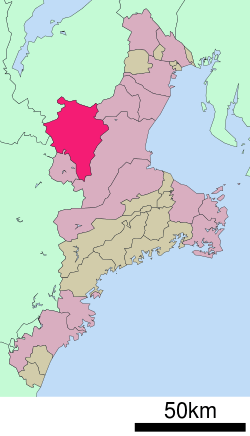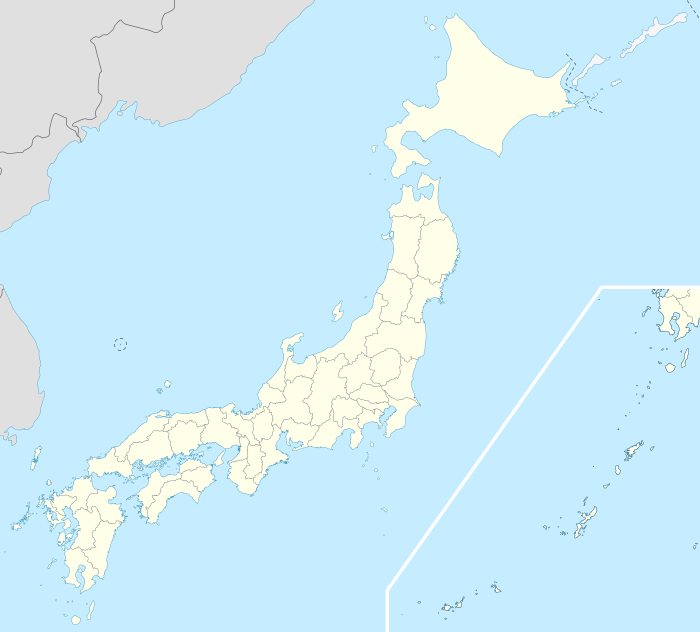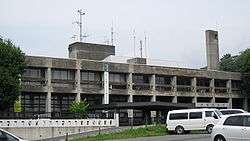Iga, Mie
| Iga 伊賀市 | |||
|---|---|---|---|
| City | |||
|
Iga-Ueno Castle | |||
| |||
 Location of Iga in Mie Prefecture | |||
 Iga
| |||
| Coordinates: 34°46′N 136°8′E / 34.767°N 136.133°ECoordinates: 34°46′N 136°8′E / 34.767°N 136.133°E | |||
| Country | Japan | ||
| Region | Kansai | ||
| Prefecture | Mie Prefecture | ||
| Government | |||
| • Mayor | Sakae Okamoto | ||
| Area | |||
| • Total | 558.17 km2 (215.51 sq mi) | ||
| Population (November 2012) | |||
| • Total | 95,137 | ||
| • Density | 170/km2 (400/sq mi) | ||
| Time zone | Japan Standard Time (UTC+9) | ||
| City symbols | |||
| • Tree | Japanese red pine | ||
| • Flower | Sasayuri (Lilium japonicum) | ||
| • Bird | Green pheasant | ||
| Phone number | 0595-22-9601 | ||
| Address | 116 Ueno Marunouchi, Iga-shi, Mie-ken 518-8501 | ||
| Website |
www | ||

Iga (伊賀市 Iga-shi) is a city located in central Kii Peninsula, in the mountainous western Mie Prefecture, Japan.
As of September 2012, the city has an estimated population of 95,137 and a population density of 170 persons per km2. The total area is 558.15 km2.
Neighboring municipalities
- Mie Prefecture
- Shiga Prefecture
- Kyoto Prefecture
- Nara Prefecture
Climate
Iga has a humid subtropical climate (Köppen climate classification Cfa) with hot summers and cold winters. Precipitation is significant throughout the year, but is heaviest from June to September.
| Climate data for Ueno/Iga, Mie | |||||||||||||
|---|---|---|---|---|---|---|---|---|---|---|---|---|---|
| Month | Jan | Feb | Mar | Apr | May | Jun | Jul | Aug | Sep | Oct | Nov | Dec | Year |
| Average high °C (°F) | 7.5 (45.5) |
8.1 (46.6) |
11.9 (53.4) |
18.4 (65.1) |
23.0 (73.4) |
26.0 (78.8) |
29.9 (85.8) |
31.2 (88.2) |
26.9 (80.4) |
21.0 (69.8) |
15.7 (60.3) |
10.5 (50.9) |
19.18 (66.52) |
| Daily mean °C (°F) | 2.4 (36.3) |
2.9 (37.2) |
5.8 (42.4) |
12.0 (53.6) |
16.8 (62.2) |
20.8 (69.4) |
24.7 (76.5) |
25.6 (78.1) |
21.5 (70.7) |
15.0 (59) |
9.4 (48.9) |
4.6 (40.3) |
13.46 (56.22) |
| Average low °C (°F) | −2.1 (28.2) |
−1.7 (28.9) |
0.3 (32.5) |
6.0 (42.8) |
11.0 (51.8) |
16.4 (61.5) |
20.8 (69.4) |
21.3 (70.3) |
17.3 (63.1) |
10.0 (50) |
4.1 (39.4) |
−0.5 (31.1) |
8.57 (47.42) |
| Average precipitation mm (inches) | 46.0 (1.811) |
58.0 (2.283) |
92.3 (3.634) |
120.7 (4.752) |
133.3 (5.248) |
215.9 (8.5) |
211.5 (8.327) |
142.8 (5.622) |
173.6 (6.835) |
114.8 (4.52) |
63.7 (2.508) |
37.4 (1.472) |
1,410 (55.512) |
| Average snowfall cm (inches) | 8 (3.1) |
8 (3.1) |
3 (1.2) |
0 (0) |
0 (0) |
0 (0) |
0 (0) |
0 (0) |
0 (0) |
0 (0) |
0 (0) |
1 (0.4) |
20 (7.8) |
| Average relative humidity (%) | 72 | 72 | 71 | 72 | 73 | 78 | 80 | 79 | 81 | 79 | 78 | 75 | 75.8 |
| Mean monthly sunshine hours | 121.9 | 112.0 | 145.0 | 154.9 | 174.7 | 127.3 | 150.4 | 175.6 | 122.9 | 132.3 | 121.2 | 126.9 | 1,665.1 |
| Source: NOAA (1961-1990) [1] | |||||||||||||
History
The area around the modern city of Iga corresponds to a portion of ancient Iga Province. The area was noted in the Sengoku period as one of the centers for ninjutsu. The town developed in the Edo period under the Tokugawa Shogunate as a castle town under Iga Ueno Castle. Iga is known as the birthplace of the haiku poet Matsuo Bashō and the home of the ninja Hattori Hanzo.
The city of Ueno was founded on September 10, 1941. It was renamed Iga on November 1, 2004 following a merger with the towns of Iga (former) and Ayama, the villages of Shimagahara and Ōyamada (all from Ayama District); and the town of Aoyama (from Naga District).
Transportation
Railway
- JR West – Kansai Main Line
- Tsuge - Shindō - Sanagu - Iga-Ueno - Shimagahara
- JR West – Kusatsu Line
- Kintetsu – Osaka Line
- Iga Railway – Iga Line
Highway
Education
International schools:
- Colégio Positivo - Brazilian primary school[2]
Local attractions
Two of Iga's main tourist attractions are the Iga Ueno Castle and the Iga-ryū Ninja Museum (the area around the city being the historical home of the famous Iga Ninja). There is also an annual Iga Ueno Ninja Festa ninja festival (April 1 to May 6).
Other not so well known attractions include:
Otogitoge Pass is one pass that Tokugawa Ieyasu passed over as he hurriedly crossed Iga to return to Okazaki, helped along by the people of Iga and Koka, during the Honnoji War.
Momochi Fortress is the fortress of Momochi Tanbanomikami, who is said to be one of the three great ninja, and nearby is Seiunzenji, where his grave is located.
Sainenji Temple is a Jodoshu (Pure Land) temple and is the burial place of Fujibayashi Samujiyasutake, the author of one of the great books of ninjutsu, “Bansenshukai”.
Fujiwara no Chikata Kutsu is the castle of Fujiwara no Chikata who appears in the Taiheiki, or Records of Great Peace.
International relations
-
 - Jurong, Jiangsu, China
- Jurong, Jiangsu, China
Noted people from Iga
- Wasabi Mizuta – voice author
- Kazuhiro Yamaji – actor, voice actor
- Jirō Kawasaki - politician
- Hakaru Hashimoto – medical scientist
- Matsuo Bashō - poet
- Kippei Shiina - actor
- Chiyonokuni Toshiki - sumo wrestler
- Ichizo Nakata - professional soccer player
- Koji Nishimura - professional soccer player
See also
External links
| Wikimedia Commons has media related to Iga, Mie. |
- Iga City official website (Japanese)
-

Wikivoyage has a travel guide for Iga.
References
- ↑ "Omu Climate Normals 1961-1990". National Oceanic and Atmospheric Administration. Retrieved December 29, 2012.
- ↑ "Escolas Brasileiras Homologadas no Japão" (Archive). Embassy of Brazil in Tokyo. Retrieved on October 13, 2015.

